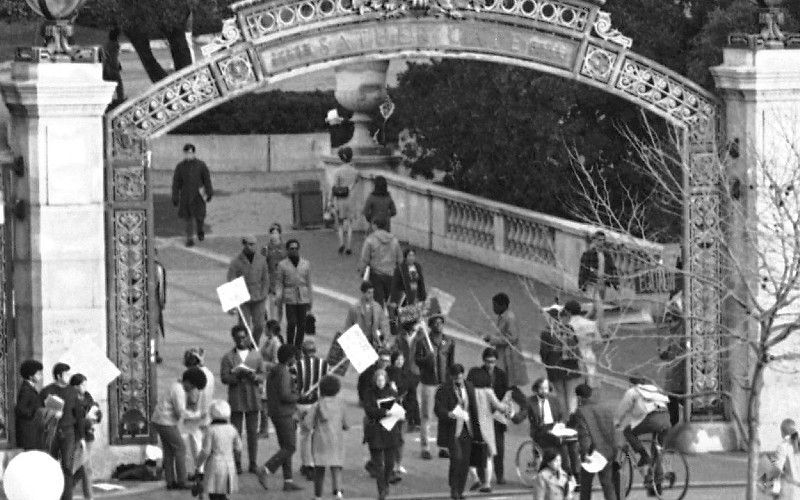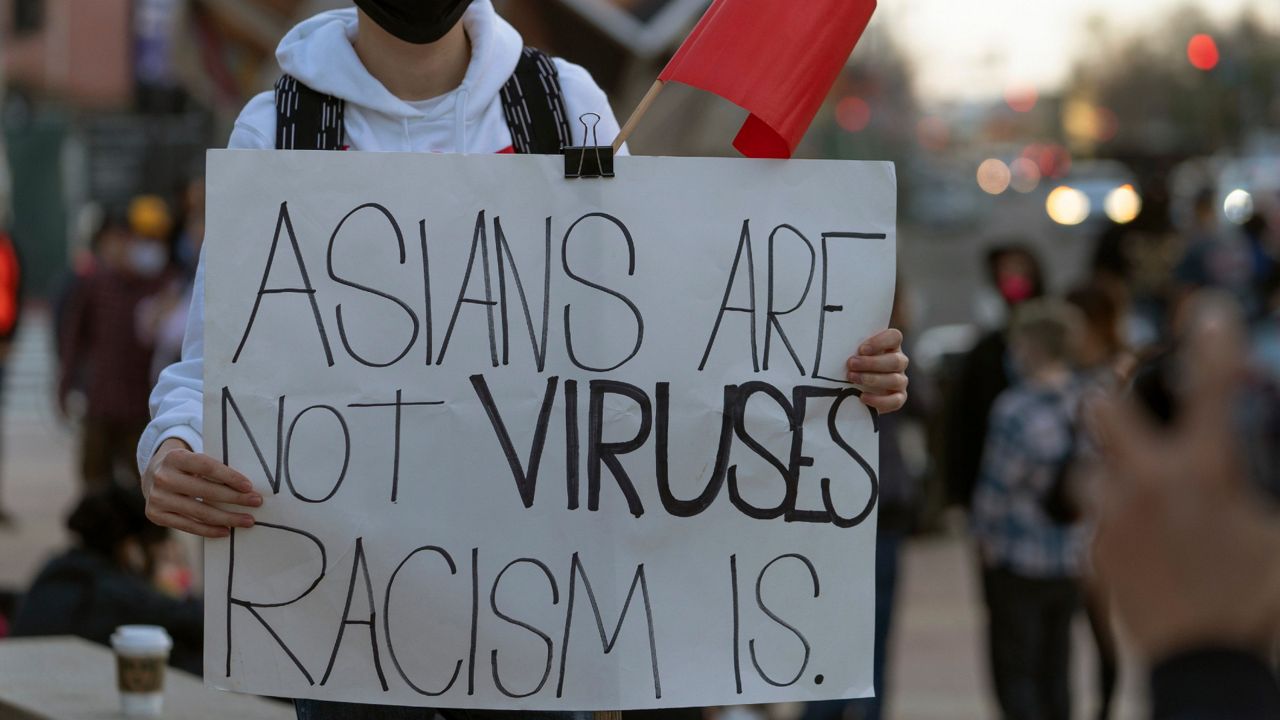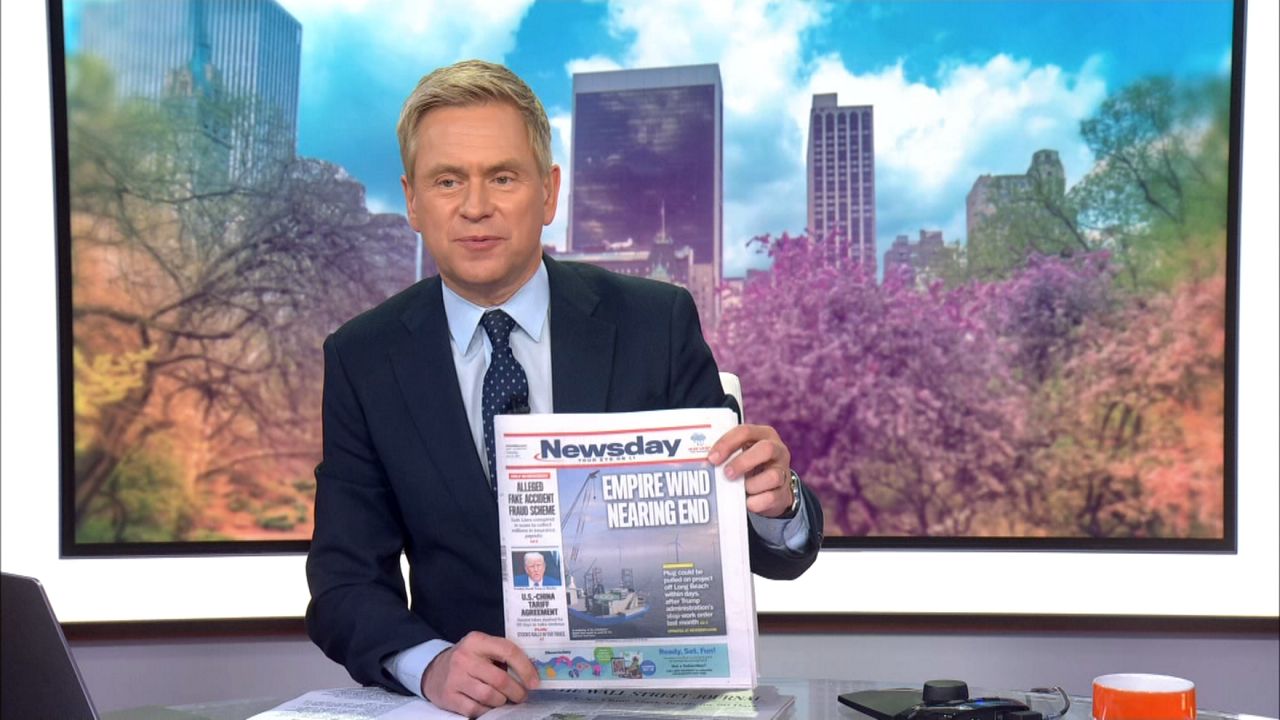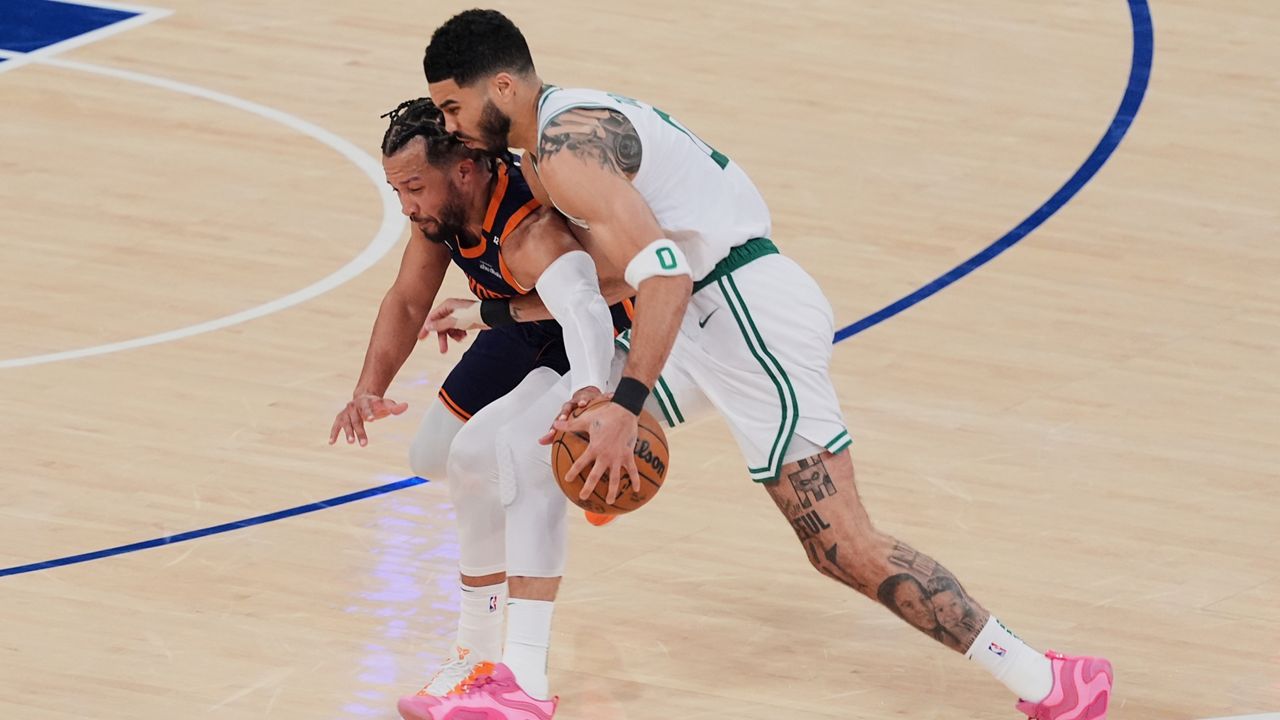NEW YORK — At the start of the pandemic, Mimi Lau felt a general unease permeating the city. But as a Chinese woman, she was dealing with a heightened level of fear after an assault on the subway.
“It was the first time I've ever seen Manhattan so dead,” she said. “And if anything did happen, nobody would know. And I still remember that night when I was in the subway.”
She said she was riding the subway home that night and noticed how empty the trains were. There were only about six other people in her car, she said.
As the train moved through Brooklyn, she said a man sitting across from her started hurling verbal attacks.
“The guy started getting really aggressive and assaulting me and verbally saying that I was dirty, I needed to go out of the subway, like, ‘get out of here,’ and said that I was having a virus,” she recalled.
At first, she didn’t realize the attacks were directed at her, but she said she could hear the insults clearly.
“And then it just started getting very scary when he actually just got up from his seat and approached me,” she said. “He grabbed my phone from my hand because I was trying to do something on my phone, and he had one fist in the air that was literally about to hit me.”
It was at that point that a couple of bystanders intervened and interrupted the escalating assault, she said.
After the man was subdued, she said she tried to ask why he was acting aggressively.
“The guy was just saying, ‘I mean, look at her. She's so dirty. She needs to get out of here,’” she recalled.
“He literally said he wasn't afraid to hit me and he needed to. At that point, I was in tears crying.”
A Rise in Anti-Asian Assaults, Potential Rise in Ethnic Strife
The subway assault Lau describes came amid a growing number of anti-Asian attacks across the country. Research compiled by Stop AAPI Hate, a national coalition aimed at addressing anti-Asian discrimination amid the pandemic, revealed nearly 3,800 incidents were reported over the course of the last year. A disproportionate number of those attacks targeted women.
Many elected officials and advocates say the rise in attacks is a result of former President Donald Trump’s rhetoric about China’s role in the spread of coronavirus and his fear-mongering over the Chinese economy.
In New York City, the number of attacks classified by the NYPD as hate crimes against Asians in 2019 was three. In 2020, it jumped to 28, an 833% increase.
And as of March 2021, that number is now six. According to NYPD Deputy Inspector Stewart Loo, the city’s on pace to not only match last year’s number but likely go higher.
In August of last year, the NYPD announced a task force specifically created to combat these crimes. The unit, headed by Loo, is composed of 25 volunteer Asian officers who speak 11 languages.
And after the shooting in Atlanta on Tuesday across three different spas that left 8 people dead, at least six of whom appeared to be Asian women, the NYPD deployed counterterrorism officers to Asian communities “out of an abundance of caution.”
But it's not just law enforcement responding to these attacks. Community organizers are using this moment to call for cross-cultural solidarity to address this wave of attacks.
Although the suspect in Atlanta was white, a number of the perpetrators across the country who have garnered attention appear to be Black. Though there's no available data indicating a higher number of these types of crimes perpetrated by Black assailants, this situation has led some advocates to fear a rise in anti-Black sentiment within the Asian community.
Already on social media platforms, posts have circulated amplifying the racial dynamics of these crimes. And it’s not hard to find conversations in Facebook comments about what some perceive as indifference on this issue from Black Lives Matter supporters.
This is the latest chapter of a long history in which economic and immigration policies along with demonizing rhetoric and representation have served to pit these two communities against one another.
"We have stories going viral that make it seem that the majority of the perpetrators are African American," said Scott Kurashige, chair of Comparative Race and Ethnic Studies at Texas Christian University. "In fact, the problem we need to address is the tendency in the dominant culture to reinforce the idea that the perpetrators are predominantly African American or non-white because that fulfills the purpose of the model minority myth, which is to put the focus on tensions and conflicts amongst communities of color rather than the systemic problem with white racism and white supremacy."
Tackling the Root of the Problem — Asian Americans as Scapegoat
This wave of crimes against Asians has left many Chinatown residents on edge.
In response, police have increased their presence in big city Chinatowns like San Francisco and NYC.
And while the NYPD has responded with its all-Asian task force, many advocates, like Jenn Fang, the founder of the Asian American blog, Reappropriate, say increased protection is not solving the underlying issue.
“The idea is to really tackle the root of the problem, which is to say, tackle how Asian Americans have been scapegoated by the rhetoric of the past couple of years and really try to come up with solutions that aren't sort of Band-Aid solutions to individual incidents,” she explained.
The first step is understanding the exclusionary laws that enabled the isolation of Chinatowns in the first place.
“Chinatowns are spaces that cropped up because of redlining and other forms of racial segregation, specifically as places that pushed a lot of different communities of color into very densely populated spaces as a way to keep them away from white folks in cities like Los Angeles and New York City,” said Fang.
She says that Asians and other people of color were forced into the least desirable parts of land at that time and lived right on top of each other.
“So in a Chinatown kind of situation, where Asian Americans are being scapegoated, if there is existing interracial tension that has been fanned by race-baiting rhetoric, you're oftentimes going to get sort of like a collision between Asian Americans and the people who are living in that neighborhood,” Fang said.
And with this neighborhood structure, there’s a history of combustibility, particularly the riots of 1992 in Los Angeles following the police beating of Rodney King.
Kurashige lived in Los Angeles at the time and said he noticed the coverage shift away from police brutality and instead to inter-ethnic conflict.
“The focus quickly shifted away from state violence and systemic patterns of anti-blackness and police brutality towards ‘black and Korean people hate each other,’” he said. “‘The Korean store owners are vigilantes picking up guns and black residents want to burn down the Korean stores.’ It's not to deny that those things happened. They certainly did. The question really is a political and ideological one—how do we make sense of what's happening? Do we recognize that there's a broader system in which we're all operating or do we focus on the anecdotal stories out of context?”
That context is one in which Asians have been used not only as scapegoats, going as far back as the 1800s with “yellow peril,” but as a continual wedge between communities of color in service of white supremacy, experts say.
One of the main tools propagating this divide is the idea of the ‘model minority myth.’ It posits that Asian Americans have been able to lift themselves up in society by sheer force of will and hard work. That stereotype not only misrepresents data — in fact, Asians have one of the highest poverty rates in New York City — but it undercuts the role of structural racism in creating inequality.
“We don't want to repeat the past,” said Julie Ae Kim, co-founder of the Asian American Feminist Collective. “How can we start thinking through how our struggles are related and how our struggles are intertwined—whether it's with housing or food insecurity or health disparities.”
Advocates like Kim warn against increased police presence as a solution, pointing to concerns that over policing ends up hurting the marginalized communities they're meant to serve. Instead, Kim and others emphasize that poverty and historic disenfranchisement are the root causes of so many of the issues at play.
“A lot of the struggles are rooted in bigger issues that are very, very hard to fix,” she said. “That's why it's easier not to point at the larger, systemic issues at hand. People might want to quickly put a Band-Aid on it and say, ‘OK, what we need to do is just report the crime more.’ But that is an after the fact [solution]. That's not actually addressing the violence that's happening.”
Building Solidarity as Part of the Healing Process
The trauma of the subway assault left its mark on Mimi Lau. But months went by, and she worked hard to heal by leaning on her community for support.
But she says all of that work was challenged when another incident occurred outside her shop around November of last year.
She was helping out with a Postmates order when the courier accused her of sneezing on the bag.
“I was really appalled because there was no sign of me even sneezing,” she said.
He insisted that he saw her sneeze on the bag and refused to take the order, she recalled.
“He got really aggressive as well, so I didn't even bother saying anything else,” said Lau. “He started banging on my storefront door. It was really scary.”
The experience triggered a wave of emotions for Lau.
“My whole body was shaking,” she said. “I couldn't even stand, and I couldn't even talk on the phone properly because I was shaking. It gave me all of those flashbacks, and I was just really, really scared.”
The work of healing after that incident now is a much steeper hill for her to climb.
“It's probably going to just take a lot more time for myself to really heal,” said Lau.
For instance, she says she automatically gets defensive now when anyone asks her ethnicity.
“I shouldn't be feeling like that,” she said.
Advocates say that for victims like Lau, the conversation about structural inequality might not be something they even have the capacity to contemplate as they’re likely thinking about safety and dealing with a host of daily mental health stressors.
“You can't just make that big jump without talking about the immediate day-to-day for folks,” said Thomas Yu, co-executive director of Asian Americans For Equality.
But in spurring pragmatic solutions for safety — like volunteer escorts — these specific incidents can serve as a jumping off point for broader discussions.
“I think there's a yearning within other groups to say that, ‘Hey, please don't see that other person as representative of all of us. Here I am coming to help you, and I hope that you see that,” said Yu. “That does help the healing process.”
While his organization works to address the needs of the Asian community, their services — like their affordable housing assistance, small business lending program, food pantries and more — are open to anyone who needs it.
This community building is part of a larger legacy of Black and Asian solidarity that goes at least as far back as the 1960s.
“Solidarity is sort of a tradition that serves at the core of Asian American movement organizing,” said Fang.
For instance, Japanese Americans supported efforts to repeal the Emergency Detention Act over concerns that Black activists could be subjected to the same kind of treatment they experienced in internment camps during World War II.
And in the late 1960s, Asian American students rallied alongside Black students during the Third World Liberation Front movement at colleges in the Bay Area. These student strikes led to equal education opportunities and the creation of ethnic studies programs in universities across the state.
In fact, AAFE was inspired by black activists during the civil rights movement of the 1970s, according to Yu.

“Now we're going back to other neighborhoods almost as a debt we owe to help others,” he said. “It reinforces that those bonds are still strong and still there and that we can repair this and those people that did this? We should all condemn them, not just from one group.”
That’s why enlisting people across ethnicities to support the Asian community is so vital in this moment, advocates say. It’s what groups organizing volunteer escorts and patrols like the Chinatown Block Watch in NYC are doing as well as localized instances around the country as well.
“Racists often don't come out and perform the most egregious acts when they know there's a lot of people watching,” said Yu. “You're held responsible by other people than just the kind of victims that you're targeting.”
It’s that kind of support from strangers that has made all the difference for Mimi Lau.
“The most important part was that there were bystanders that actually stood up for me,” she said. “That really helped me know that if I was ever in a situation, there are good people out there. It's not just all bad people. Knowing that there were people watching and listening and making sure I was OK — I feel really grateful.”
Editor's Note: An earlier version of this story incorrectly stated that Rodney King was murdered. He was beaten by police.








_Queens_New_Trees_PKG_CG_FIX_2_134189101_23)